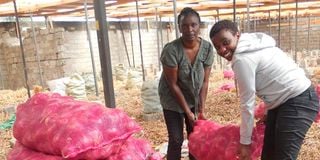Premium
Control of weeds in onion production

Farmers with their onion produce ready for the market. One should monitor and keep records of weeds on the farm, especially during scouting.
The previous article looked at downy mildew as a disease likely to affect onions. In this piece, we discuss weeding as a management practice.
One of the management practices by Desmond is ensuring the land is free of weeds.
Weeding is the removal of unwanted or undesirable plants from the farm. This is important since weeds compete with crops of interest for growth factors like nutrients, moisture and space.
Weeds may suppress the crop. They may also harbour pests and diseases, thus reducing yield.
It is important to have integrated weed management systems. This involves a combination of cultural, mechanical and chemical methods of controlling weeds.
Weed management should begin during land preparation.
To avoid introducing weeds into the farm, the manure used should be well-rotten and needs to come from a reliable source.
Onions should be planted in the most weed-free fields available. Avoid fields with a high concentration of difficult-to-control perennial weeds like nutsedge.
This helps reduce the cost of weeding. The farmer should also use seeds that are weed-free.
Remember, onion is a shallow-rooted crop and removing perennial weeds may result in uprooting the plant. Before seeding the farm, control weeds that grow there.
The onion’s narrow upright leaves do not compete well with weeds as they do not have a ground cover.
Weed control in onions is also challenging due to the crop densities and the inadequacy of appropriate tools.
Hand weeding is essential. As said earlier, ensure you do not uproot the onions.
Mechanical methods like the use of a jembe, can be used to weed in between the paths and edges.
Chemical methods can also be applied. Desmond used herbicides in the first two weeks after transplanting to control germinating weeds.
After this, herbicides should be avoided as they suppress the growth of the onion seedlings. The farmer should determine the suitability of the chemical before spraying by reading the label.
One should monitor and keep records of the weeds on the farm during scouting. The records will be useful while identifying suitable blocks to grow onions in the next season.
The records also help to identify the hard-to-control weeds and allow appropriate measures to be put in place. It is important to get rid of weeds as soon as possible since smaller weeds are easier to kill than bigger ones.
Due to the nature of growth, cover cropping is rarely used to control weeds in onion production. However, it can be used in crop rotation to control weeds in the next crop cycle.
The farmer should also be careful when using cover crops because annual weeds tend to take hold when cover crops are used.
We shall look at the current market trends in onion production in our next article.





